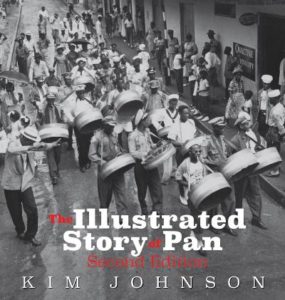|
Getting your Trinity Audio player ready...
|
Reading Time 2 mins
March 30, 2021
In The Illustrated Story of Pan (Second Edition), Kim Johnson delivers on his promise of “a book akin to a photo album.” It feels personal. In fact, a photograph of my father, Selwyn Henry, is featured in an early chapter called “The Audacity of The Creole Imagination.” It is a 1950s snapshot of the Casablanca Steel Orchestra. He is a boy among men, all wearing costumes emblazoned with symbols of the French, playing a tenor pan. In a flash of grey, black, and white tones, my family becomes your family.
a photo album.” It feels personal. In fact, a photograph of my father, Selwyn Henry, is featured in an early chapter called “The Audacity of The Creole Imagination.” It is a 1950s snapshot of the Casablanca Steel Orchestra. He is a boy among men, all wearing costumes emblazoned with symbols of the French, playing a tenor pan. In a flash of grey, black, and white tones, my family becomes your family.
But The Illustrated Story of Pan is not simply a photo album. The kind that, relegated to a coffee table, jostles for space between a hodgepodge of knick-knacks and coasters. To describe it like that is to miss what is possible when a book makes meaning out of memory. To limit the book’s success at creating a steelpan odyssey, where the photographs are both ship and captain.
More than an assemblage of photography and prose, Johnson arrests readers with the quality of research expected of a venerable journalist and his nuanced commentary about steelpan’s inventors, supporters, and even detractors. It is a fine balance that is maintained for the book’s 10 chapters as it traces the ancestral history of the instrument to its modernisation. For instance, “Repercussions 1880 – 1939” tells the story of pan’s beginning from bamboo to metal, while the dogged pursuit of music-making (“Makin’ Style,” “Mas with Class,” “Forged from the Love”) lead to pan’s introduction to the world (“Render unto Caesar,” “New Beginnings”). A curated selection of entertaining interviews deepens the storytelling experience.

“Women’s role in pan is as elsewhere: vital and varied… The rebellious 1970s saw young women forming school bands [pushing] pans into the educational system, transforming themselves and the steelband movement in the process.”
 mentioned; they are celebrated throughout much of the book. Names such as Daisy James, Hazel Henley, Louise McIntosh, Michelle Huggins-Watts, Vanessa Headley should now roll off tongues as easily as Ellie Mannette, Bertie Marshall, Rudolph Charles, and Anthony Williams.
mentioned; they are celebrated throughout much of the book. Names such as Daisy James, Hazel Henley, Louise McIntosh, Michelle Huggins-Watts, Vanessa Headley should now roll off tongues as easily as Ellie Mannette, Bertie Marshall, Rudolph Charles, and Anthony Williams.
The history of the steelband movement is also the history of a nation. Intersections of race, class, and gender both cavorted and clashed in panyards and in the streets. As much as the instrument played a foundational role in Trinidad and Tobago’s mas culture, its place on the political stage cannot be ignored. Johnson’s insights into the cast of characters linked to the latter may even come as a surprise to some.
While Johnson dares to enter the murky territory of who did what first and best, it is clear that his objective is love. He wants the world to know about the gift that is steelpan.
The Illustrated Story of Pan will make you want to wave a flag for your neighbourhood and, by extension, your band. And if you have no band, be inspired to pick one. Put a copy of this book in your car, your suitcase, your nightstand, and yes, on your coffee table. It is a collectible worth sharing.
*Click here to order The Illustrated Story of Pan.
_ _ _ _ _ _ _ _ _
 Simone Dalton is an author and a former Panorama and stage side tenor pannist turned pan philanthropist. Born and raised in Trinidad and Tobago, she started a foundation to support education for young steelpan artists and creatives. Read about her work at daltonfdn.org.
Simone Dalton is an author and a former Panorama and stage side tenor pannist turned pan philanthropist. Born and raised in Trinidad and Tobago, she started a foundation to support education for young steelpan artists and creatives. Read about her work at daltonfdn.org.

